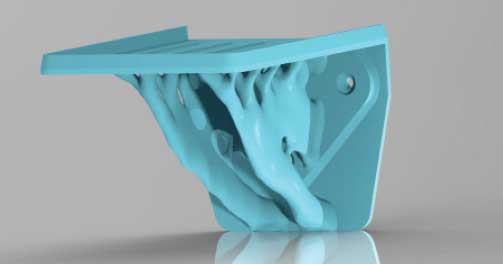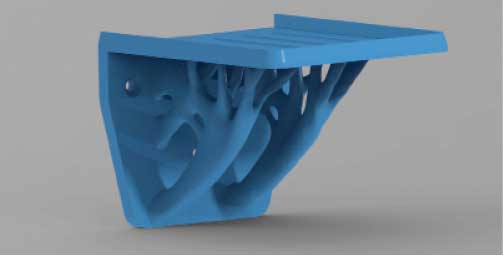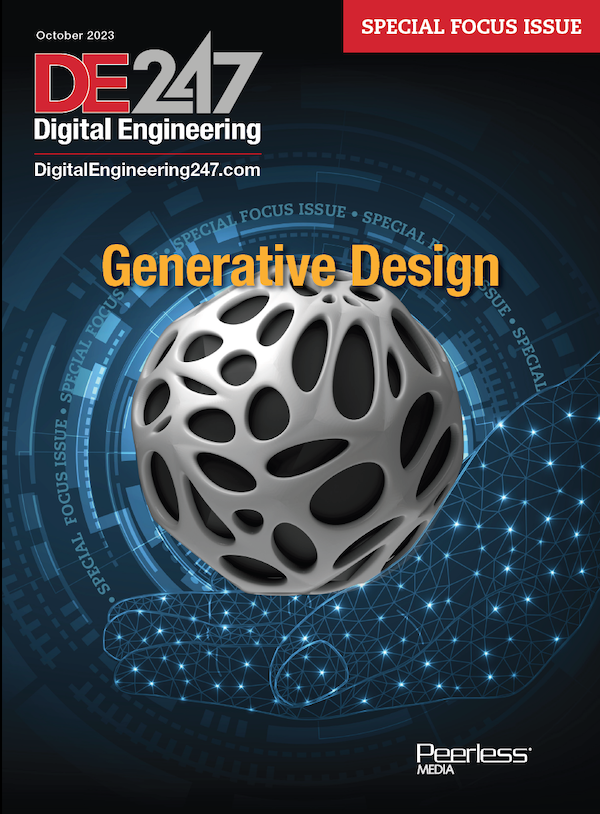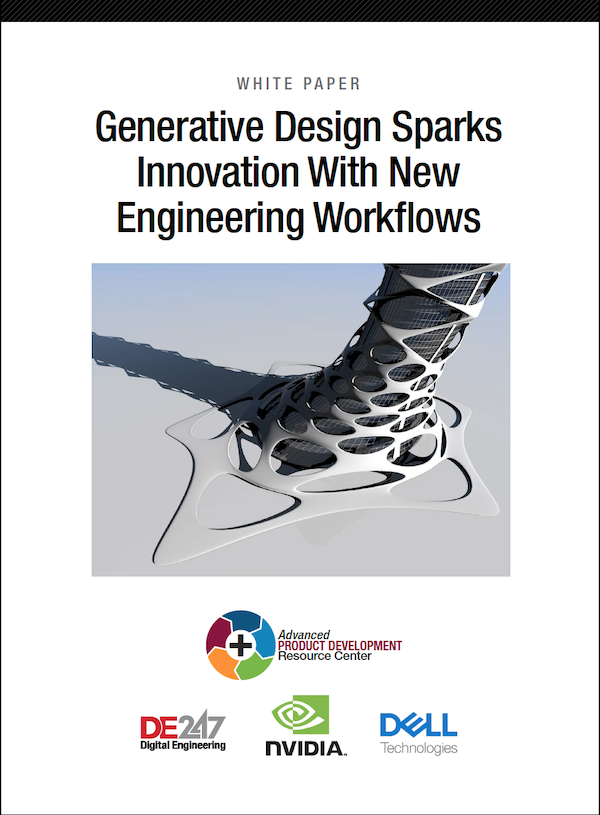
New data sets with AI and human intelligence are changing the game. Image courtesy of Carbon Lighthouse.
May 15, 2020
Artificial intelligence (AI) is pervasive and changing the entire landscape of engineering design. The technology is further being incorporated into generative design capabilities and adaptive user interfaces and predictive analytics. It helps provide features that can speed up engineering design and help engineers make better decisions faster.
The global AI software mark is on track to grow fivefold and reach $126 billion by 2025, according to data gathered by LearnBonds. The firm’s research to date shows that one in five workers in a non-routine job will rely on AI for at least part of their role soon, noting that the growing volume and complexity of business data have forced many firms across a variety of industries to adopt AI to boost growth.
The research notes that AI has already begun to “revolutionize” industries globally, helping businesses to improve their efficiency, quality and speed. With the help of automation, deep learning and natural-language processing, LearnBonds indicates that AI can help streamline business operations and decision-making and predict trends.
Generative Design for Greater Efficiency
Streamlining business operations, making better decisions and predicting outcomes are all supported in generative design—a design process where iterations are created and analyzed virtually, using machine learning, deep learning and the deeper capabilities of AI.
Use of AI and deep learning, and subsequent integration into engineering design and simulation software, has been groundbreaking, according to Jesse Coors-Blankenship, senior vice president of technology, advanced development at PTC.

“With generative design, manufacturers can now drive workforce productivity by proactively addressing the skills gap,” Coors-Blankenship says. “An entry-level mechanical engineer can now create a part through generative design without extensive knowledge of manufacturing processes that a senior engineer would have from years in the field.
By approaching part ideation and creation through these new techniques, manufacturers can make smarter business decisions, according to Blankenship.
He notes that AI will afford engineers the ability to best execute generative designs when striving to achieve design objectives. Generative design with AI also allows engineers to explore traditional and advanced manufacturing techniques to get differentiated products, bringing value to productivity and to competitive differentiation.

“With generative [design], engineers can take advantage of advanced manufacturing techniques and embrace additive manufacturing,” Coors-Blankenship adds.
A Simulation Evolution and Revolution
Incorporating AI and machine learning (ML) technologies—including deep learning—into engineering design and simulation software represents a significant evolution for the modeling and simulation industry, enabling highly precise designs to be created faster than ever, according to Prith Banerjee, chief technology officer at ANSYS.
AI- and ML-embedded simulation software delivers a capability that is truly disruptive as the software autonomously learns or teaches itself how to solve complex design problems to deliver highly precise products.
The same applies to the software. He explains that this embedded simulation is also disruptive for designers as it democratizes simulation, opening the door for practically anyone—even engineering novices—to create simulations.
Starting with a basic set of parameters, the software rapidly simulates a product and expedites its path to customers. He emphasizes that this new capability will greatly enhance the user experience for creating better and smarter designs—through four key benefits.
“First, it drastically decreases your workload and boosts your productivity as the software automatically chooses the best simulation solver parameter settings for each job,” says Banerjee. “Second, its state-of-the-art inference capabilities produce designs with extraordinary speed, reducing thousands of hours of solving time to just a few minutes.
“Third, it powers generative design as it creates countless product designs and selects the top designs for consideration—empowering you to choose the best one for physical prototyping,” Banerjee continues. “Lastly, integrated with digital twin data, the software helps you decipher how your product performs and improves simulation accuracy to enhance the design of next-generation assets.”
Simulation capabilities are a big deal, a game changer for engineering design and they just keep getting better every year.

Jean-Simon Venne, chief technology officer at BrainBox AI, says his company has proven that data-driven models generate the same level of accuracy as complex simulation models. “More importantly, a data-driven model powered by neural networks will get you the same precision in terms of the simulation prediction but with a lot less effort in term of hours,” he says.
In contrast, Venne says it would take a deep learning neural network half a day to do the same. “Due to this, AI will replace a significant amount of digital twin initiatives,” he notes. “In addition, once a critical mass of metadata is created, it would become possible to actually generate plan and specifications for a building instead of having an engineer designing them.”
With this support for digital twin initiatives and optimization capabilities, AI can bring time savings for engineers and allow them to work on the big picture.
The real benefits of AI and deep learning (DL), according to Tonya Custis, director of AI research for Autodesk, will be time and cost savings derived from “optimizing the combined powers of what computers are good at—ingesting lots of data, running lots of simulations, finding patterns in data, optimizing for physical, legal and cost constraints—and what people are good at—designing objects to fit a purpose, building things, seeing the big picture, making decisions.”
She says AI will help engineers leverage available data to make smarter decisions, additionally enabling an automatic and seamless way to incorporate past decisions, learnings, observations and outcomes back into the design process. By revising AI algorithms with new data as it becomes available, design software will become smarter.
Becoming Smarter
Becoming smarter and using AI to create good things and positive change is what San Francisco-based Carbon Lighthouse does. The company uses AI in its pursuit to help commercial and industrial buildings become carbon neutral, says Brenden Millstein, CEO/co-founder, Carbon Lighthouse.
He says simulation models and software are powerful tools. His firm uses them to simulate building performance and gather data into a simulation engine called CLUES. It allows them to compare predictions to reality.
This is where AI, deep learning and cheap sensors from recent improvements of the Internet of Things (IoT) are of large value. By gathering data from existing buildings, and using AI to make sense of that data, Carbon Lighthouse can dramatically refine CLUES.
The main benefits are primarily from comparing real-life performance to simulation. Millstein says their simulation model helps determine equipment and its suitability for a system.
“Only by comparing predictions with reality can we continue to improve simulation and design, and thankfully [Internet of Things] and AI in combination allow us to do exactly that,” Millstein says. “While water-cooled chillers are theoretically more energy efficient than water-source heat pumps, CLUES analysis of our real-world data shows that in actuality water-source heat pumps are more efficient. This is likely due to the complexity of water-cooled chiller systems.
“So even though the simulation software is accurate to begin with, real life shows equipment is used differently than designed,” Millstein continues. “In the 100 million square feet of real estate Carbon Lighthouse has analyzed, these differences are large enough that most buildings would likely have been better off if they had been specified with water-source heat pumps in the first place instead of chillers!”
The Optimistic Future of Engineering Design
Custis argues that AI will ultimately augment, not replace, engineers, allowing them to make them better, faster and more informed design decisions. “AI will automate repetitive, time-consuming and low-level tasks, while giving engineers and designers more time to focus on the human and aesthetic elements of design,” she adds.
Custis reminds organizations of an untold risk about AI and DL: not embracing it. The tools and technology are there. Incorporating it means change. It means learning and embracing the technology and putting it to use in your design practices and in the technology and software tools you use.
Doing nothing is a lost opportunity; innovative companies embrace simulation to reduce product development and systems risk, and allow AI to figure out solutions to problems that the human mind does not have the horsepower to figure out.
“The real game changer, in a negative light, would be not to incorporate AI and DL technologies into engineering design and simulation software,” Custis says. “In five years, we won’t be talking about ‘AI features’ in software—it will just be taken for granted that software includes and is powered by AI and DL. Companies that do not incorporate AI and DL will be left behind and won’t be able to compete.”
More Ansys Coverage
More Autodesk Coverage
More PTC Coverage
Subscribe to our FREE magazine, FREE email newsletters or both!
About the Author
Jim Romeo is a freelance writer based in Chesapeake, VA. Send e-mail about this article to [email protected].
Follow DE







